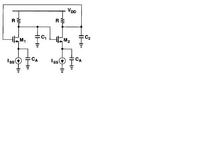LvW
Advanced Member level 6
Khaled, I completely agree with you - and I really appreciate your approach to find a rough estimate for the circuit´s behaviuor with the aim to get a feeling for electronic circuits.
And believe me, I was not very happy with my answer "too involved".
But in this particular case I am afraid I cannot help you - also with respect to the time needed to analyze the circuit (including the most important parasitics).
For example, don´t forget: It is not a simple task to solve only a 3rd order linear equation by hand.
Let me give you another example: There are some linear oscillator circuits called "R-oscillator" with no extra capacitors. That means the only reactive element is the frequency-dependence of the opamps (at least two units).
In order to be able to analyze such a circuit and to roughly approximate its behaviour the opamp gaim is approximated by a simple integrating functio (1/sT). That`s the only way to estimate the oscillating frequency and to derive practical formulas. But in reality - because of the simplifications (and because of the uncertainties connected with the value of T) the oscillating frequency will largely deviate from the calculated value.
Good luck and regards
LvW
And believe me, I was not very happy with my answer "too involved".
But in this particular case I am afraid I cannot help you - also with respect to the time needed to analyze the circuit (including the most important parasitics).
For example, don´t forget: It is not a simple task to solve only a 3rd order linear equation by hand.
Let me give you another example: There are some linear oscillator circuits called "R-oscillator" with no extra capacitors. That means the only reactive element is the frequency-dependence of the opamps (at least two units).
In order to be able to analyze such a circuit and to roughly approximate its behaviour the opamp gaim is approximated by a simple integrating functio (1/sT). That`s the only way to estimate the oscillating frequency and to derive practical formulas. But in reality - because of the simplifications (and because of the uncertainties connected with the value of T) the oscillating frequency will largely deviate from the calculated value.
Good luck and regards
LvW
